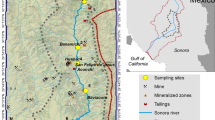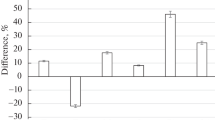Abstract
Total mercury (Hg) was determined in milk, eggs, beef, pork, human head hair, soil and water obtained from four geographical areas of North Dakota. The sampling areas were selected on the basis of differences in prevalent agricultural practices, climate and topography. Statewide average Hg concentrations in ppb were milk, 0.8; eggs, 12; beef muscle, 5; beef liver, 10; pork muscle, 11; pork liver, 15; head hair, 1708; soil, 30; rainwater and well water, less than one. There were no significant differences observed among areas in Hg content of any substance sampled except beef muscle. Beef muscle obtained from areas 2 and 4 contained significantly (P⩽0.05) higher levels of Hg than beef muscle from the other two areas. However, the magnitudes of differences were small (4 to 6 ppb). Considerable variation among individual beef and swine were noted but only six beef of 453 sampled and three swine of 156 sampled had tissue Hg exceeding 50 ppb. Appreciable variation was observed in Hg in eggs with respect to farms within an area, eggs from the same farm, and sampling times within a year. Few eggs sampled contained more than 50 ppb. Significantly (P⩽0.01) higher levels of Hg were found in head hair of women as compared with men and relatively large differences among individuals were observed. Average Hg in hair was generally low irrespective of sex of donor or area of the state as compared with data given in the literature. Soil Hg levels were consistently low in all areas of the state, and no relationship between cropping practices and soil Hg was detected.
Similar content being viewed by others
References
Bakir, F., S. F. Damluji, L. Amin-Zaki, M. Murtadha, A. Khalidi, N. Y. Al-Rawi, S. Tikriti, H. I. Dhahir, T. W. Clarkson, J. C. Smith, and R. A. Doherty: Methylmercury poisoning in Iraq. Science181, 230 (1973).
Birke, G., A. G. Johnek, L. Plantin, B. Sjostronel, S. Skerfvig, and T. Westermark: Studies on humans exposed to methyl mercury through fish consumption. Arch. Environ. Health25, 77 (1972).
Coleman, R. F., F. H. Cripps, A. Stimson, H. D. Scott, and A. W. R. E. Aldermaston: The trace element content of human head hair in England and Wales and the application to forensic science. Atom. Monthly Information Bull.,U.K. Atomic Energy Authority 12, 12 (1967).
Curley, A., V. A. Sedlak, E. F. Girling, R. E. Hawk, W. F. Barthel, P. E. Pierce, and W. H. Likosky: Organic mercury identified as cause of poisoning in humans and hogs. Science172, 65 (1972).
Dietz, F. D., J. L. Sell, and D. Bristol: A rapid, sensitive method for determination of mercury in a variety of biological samples. J. Assoc. Offic. Anal. Chem.56, 378 (1973).
Dustman, E. H., L. F. Stickel, and J. B. Elder: Mercury in wild animals, Lake St. Clair, 1970. Proc. International Conference on Environmental Mercury Contamination, Ann Arbor, Michigan, (1970).
Fimreite, N., R. W. Fyfe, and J. A. Keith: Mercury contamination of Canadian prairie seed eaters and their avian predators. The Can. Field Naturalist84, 269 (1970).
Fimreite, N., W. N. Holsworth, J. A. Keith, P. A. Pearce, and I. M. Gruchy: Mercury in fish and fish-eating birds near sites of industrial contamination in Canada. The Can. Field Naturalist85, 211 (1971).
Friberg, L., and J. Vostal: Mercury in the Environment. The Chemical Rubber Co., Cleveland, Ohio (1972).
Gibbs, O. S., H. Pond, and G. A. Hansman: Toxicological studies on ammoniated mercury. J. Pharmacol.72, 16 (1941).
Goldwater, L. J.: Occupational exposure to mercury. The Harben Lectures. J. Roy. Instit. Public Health26, 279 (1964).
Hammer, D. K., J. F. Finklea, R. H. Hendricks, T. A. Hinnero, W. B. Riggan, and C. M. Shy: Trace metals in human hair as a simple epidemiological monitor of environmental exposure. In Symposium on Trace Substances in Environmental Health, D. D. Hemphill (ed.)V, 25 (1972).
Heide, F., H. Lerz, and B. Bohm: Gehalt des Saalewasser an Blei und Quecksilber, Naturwissen.44, 441 (Cited by Sana, J. G. Residue Reviews42, 115 (1957).
Kutsuna, M.: Study Group of Minamata Disease. Kumamoto University, Kumumoto, Japan (1968).
Martin, J. T.: Mercury residues in plants. Analyst88, 413 (1963).
Ministry of Health, Japan: Report on the cases of mercury intoxications in Niigata Prefecture (1967).
Pierce, A. P., J. M. Bothbol, and R. E. Learned: Mercury content of rocks, soils and stream sediments. In Mercury in the Environment. Geol. Survey Profess. Paper 713. U.S. Government Printing Office pp. 14–17 (1970).
Saha, J. G.: Significance of mercury in the environment. Residue Reviews42, 103 (1972).
Shacklette, H. T., J. B. Boerngen, and R. L. Turner: Mercury in the environment—surficial materials of the conterminous United States. U.S. Geological Survey Circular 644, p. 5, Washington, D.C. (1971).
Somers, E.: Mercury contamination of foods. In Symposium: Mercury in Man's Environment, Royal Soc. of Canada, Ottawa, pp. 99–106 (1971).
Stock, A., and F. Cucuel: Die Verbreitung des Quecksilbers. Naturwissenschaften22, 393 (1934).
Swanson, G. A., G. L. Krapu, and H. K. Nelson: Mercury levels in tissues of ducks collected in south central North Dakota. Proc. N. Dak. Acad. Sci.25, 28 (1971).
Tanner, J. T., M. H. Friedman, and D. N. Lincoln: Mercury content of common foods determined by neutron activation analysis. Science177, 1102 (1972).
Turney, G. W.: The mercury pollution in Michigan. Report. Michigan Water Resources Commission (1970).
Wershaw, R. L.: Sources and behavior of mercury in surface waters. In Mercury in the Environment, Geol. Survey Profess. Paper 713, U.S. Government Printing Office, pp. 29–32 (1970).
Westoo, G.: Methylmercury compounds in animal foods. In Chemical Fallout: Current research on persistent pesticides, M. W. Miller and G. G. Berg (eds.), Charles C. Thomas, Springfield, Ill. pp. 75–93 (1969).
Wobeser, G., N. O. Nielsen, R. H. Dunlop, and F. M. Atton: Mercury concentrations in tissues of fish from the Saskatchewan River. J. Fish. Res. Bd. Can.27, 830 (1970).
World Health Organization: Pesticide residues in food. Joint report of the FAO Working Party on Pesticide Residues and the WHO Expert Committee on Pesticide Residues. Tech. Rep. Ser. 370 (1967).
Yamaguchi, S., and H. Matsumoto: Diagnostic significance of the amount of mercury in hair. Proc. 15th International Congress Occupat. Health, Vienna, p. 255 (1966).
Author information
Authors and Affiliations
Additional information
Published with the approval of the Director of the North Dakota Agricultural Experiment Station as Journal Article No. 493.
Rights and permissions
About this article
Cite this article
Sell, J.L., Deitz, F.D. & Buchanan, M.L. Concentration of mercury in animal products and soils of North Dakota. Arch. Environ. Contam. Toxicol. 3, 278–288 (1975). https://doi.org/10.1007/BF02220741
Received:
Accepted:
Issue Date:
DOI: https://doi.org/10.1007/BF02220741




